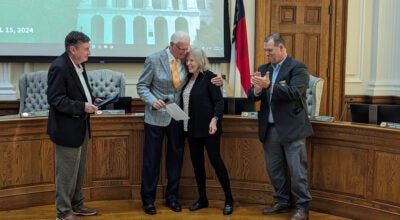NC Supreme Court ponders legality of redistricting
Published 12:00 am Tuesday, January 7, 2014
RALEIGH (AP) — The validity of North Carolina’s legislative and congressional maps is back in the hands of the state Supreme Court as attorneys argued Monday whether the boundaries comply with federal and state laws and previous court opinions.
The court’s seven justices offered few of their own questions during 90 minutes of arguments over the districts drawn by Republican legislators in 2011 for the General Assembly and North Carolina’s U.S. House delegation.
As usual, the justices gave no indication when they would rule. Many arguments focused upon redistricting decisions the state’s highest court had released over the past 10-plus years for previous boundaries. Thousands of pages of motions, briefs and background have been filed by lawyers since this round of redistricting litigation began in late 2011.
“I’m not sure there’s anything left unsaid here,” said Special Deputy Attorney General Alec Peters, defending the maps for the state.
A three-judge panel of trial court judges last summer upheld as lawful the districts, which helped the GOP expand their majorities in the legislature and win nine of the state’s 13 congressional seats during the 2012 elections. Unless the maps are struck down, they’ll keep being used through the 2020 elections, right before the next census.
Attorneys for dozens of Democratic voters as well as civil rights and election advocacy groups who sued told the state’s highest court the three Superior Court judges got it wrong. They also have filed a motion asking the justices to delay the 2014 primary while the case is decided. The filing period begins Feb. 10. Redistricting arguments delayed the 2002 and 2004 primaries.
The maps “must be held unconstitutional,” said Anita Earls, an attorney with the Southern Coalition for Social Justice, because the lower court judges made “fundamental errors.”
Earls repeated previously-made arguments that the boundaries were racial gerrymanders by creating too many black majority districts, many with odd-looking shapes, some of which were on display on poster boards placed for the justices to review. The litigation focused on 30 districts — 27 at the General Assembly and three for Congress.
Earls, who is representing the state conference of the NAACP, said mapmakers went beyond what the U.S. Voting Rights Act required by creating so majority-black districts in areas where black voters already were able to elect their favored candidates. The result, map critics say, is that black voters have seen their overall influence wane by being packed into certain districts.
“These districts go block-by-block to separate voters based on which race they belong to, dividing an unprecedented number of precincts and disregarding other political boundaries,” she said.
But the lower court rejected all of Earls’ arguments, Peters said, because they were inconsistent with previous rulings by the state Supreme Court and U.S. Supreme Court involving North Carolina. He suggested the other side was unhappy with the maps because they favored Republicans. Partisan considerations when drawing maps can be considered lawful.
The lower court judges “properly recognized that the difference between legal arguments that are for a court of law to decide, and political argument that are for the court of public opinion,” he said. Peters said the alternative districts proposed by Democratic lawmakers and their allies also had strange shaping as well.
Peters and Tom Farr, a private attorney representing Republican legislative leaders, reiterated their contention that drawing majority-black districts was a lawful method to prevent the state from subjecting itself to legal claims under the Voting Rights Act.
The Voting Rights Act had required the state to “preclear” the 2011 maps with U.S. Justice Department attorneys or a federal court before they could be used. Earls said the U.S. Supreme Court’s decision last year that essentially ended that requirement means that fear of litigation is not justified any more.
Attorneys on both sides disagreed about whether the General Assembly districts violated the state constitution’s requirement barring the splitting of counties to form House and Senate districts.




